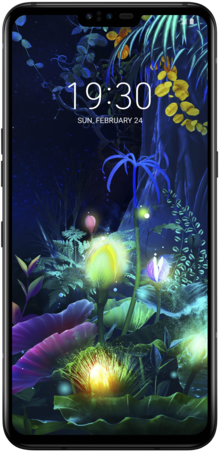A phablet (/ˈfæblət/, /-lɪt/) is a mobile device combining or straddling the size formats of smartphones and tablets. The word is a portmanteau of phone and tablet.[1] As of 2020, most budget and entry-level Android smartphones constitute the phablet form factor, as they utilize a minimum of 6.5-inch screen size and a height of 160 mm or higher. This was first popularized by Chinese brands Oppo and Infinix in 2019, which began producing larger-screen budget smartphones for developing markets such as Bangladesh, India, South Africa and Indonesia. Samsung also started producing large-screen budget smartphones since 2020, with the introduction of Samsung Galaxy A21.
Appearance[edit]
Phablets feature large displays that complement screen-intensive activity such as mobile web browsing and multimedia viewing. They may also include software optimized for an integral self-storing stylus to facilitate sketching, note-taking and annotation.[2] Phablets were originally designed for the Asian market where consumers could not afford both a smartphone and tablet as in North America; phones for that market are known for having "budget-specs-big-battery" with large low resolution screens and midrange processors, although other phablets have flagship specifications.[3][4] Since then, phablets in North America have also become successful for several reasons: Android 4.0 and subsequent releases of Android were suited to large as well as small screen sizes, while older consumers preferred larger screen sizes on smartphones due to deteriorating eyesight.[5] Examples of earlier devices with similar form factors date to 1993.[1][6][7][8] The term "phablet" was widespread in the industry from 2012 to 2014[9] although its usage has declined since average smartphone sizes eventually morphed into small tablet sizes, up to 6.9 inches.[10]
Definition[edit]
The definition of a phablet has changed in recent years due to the proliferation of larger displays on mainstream smartphones, and smartphones designed with thin bezels and/or curved screens to make them more compact than other devices with similar screen sizes. Thus, a device with a "phablet-sized" screen may not necessarily be considered one.[11][12]
Current phablets typically have a diagonal display measurement between 6.5 inches (170 mm) and 7 inches (180 mm).[13][14][12] In comparison, most flagship smartphones released in 2021 have a screen size of over 6 in (150 mm), with larger versions of mainstream flagships (such as iPhone 13 Pro Max, Pixel 6 Pro, and Samsung Galaxy S21 Ultra 5G) using over 6.6 in (170 mm) displays.[12] PhoneArena argued that the S7 Edge was not a phablet, as it has a narrow and compact build with a physical footprint more in line with the smaller-screened Nexus 5X, due primarily to its use of a display with curved edges.[11]
In 2017, several manufacturers began to release smartphones with displays taller than the conventional 16:9 aspect ratio used by the majority of devices, and diagonal screen sizes often around 6 inches. However, in these cases, the sizes of the devices are more compact than 16:9 aspect ratio devices with equivalent diagonal screen sizes.[12][15]
History[edit]
Origins[edit]
In tracing the 10 earliest devices in the history of the phablet concept, PC Magazine called the 1993 AT&T EO 440, "the first true phablet",[16] followed by the following devices:
- 2007 HTC Advantage (5.0" screen)
- 2007 Nokia N810 WiMAX Edition (4.13" screen)
- 2009 Verizon Hub (7.0" screen)
- 2010 LG GW990 (4.8" screen)
- 2010 Dell Streak (5.0" screen)
- 2011 Dell Streak 7 (7.0" screen)
- 2011 Acer Iconia Smart (4.8" screen)
- 2011 Samsung Galaxy Player 5 (5.0" screen)
- 2011 Pantech Pocket
- 2011 Samsung Galaxy Note (5.3" screen)
- 2013 Nokia Lumia 1520 (16:9 6.0" screen)
However, the form factor did not become popular until the arrival of the Galaxy Note in the 2010s. The Android-based Dell Streak included a 5-inch (130 mm), 800 × 480 display and a widescreen-optimized interface. Reviewers encountered issues with its outdated operating system, Android 1.6, which was not yet optimized for such a large screen size, and the device was commercially unsuccessful.[17][18][19]
You received this message because you are subscribed to the Google Groups "1TopReadys1" group.
To unsubscribe from this group and stop receiving emails from it, send an email to 1topreadys1+unsubscribe@googlegroups.com.
To view this discussion on the web visit https://groups.google.com/d/msgid/1topreadys1/CAForgrQtPzvC5ota6LXqEAcsfaye-32aLX6pMcHVCmi0Sa6w9g%40mail.gmail.com.



No comments:
Post a Comment